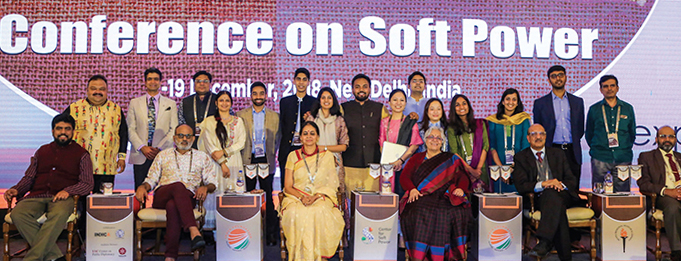Delhi’s Conference on Soft Power explored the country’s potential for global cultural and spiritual influence, apart from military might and economic vigor
BY DIMPLE KAUL, DELHI
DELHI’S ELEGANT TAJ MAHAL HOTEL was the scene of India’s first Conference on Soft Power, presented December 17 to 19, 2018, by the India Foundation’s Center for Soft Power. Collaborating in producing the event were the Indic Academy, the Indian Council for Cultural Relations and the Nehru Memorial Museum and Library, with academic support from Nalanda University in Rajgir and the Center on Public Diplomacy of the University of Southern California.
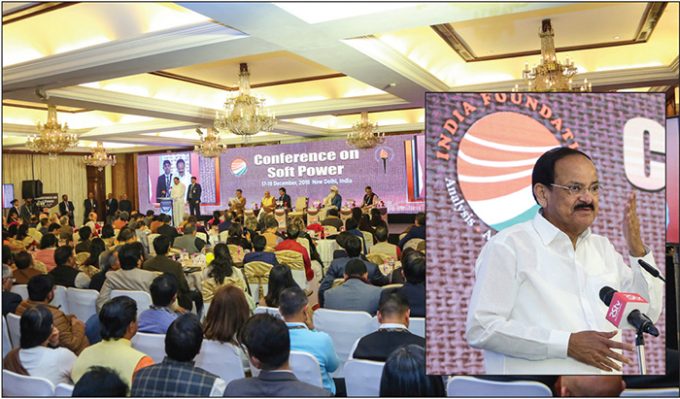
The Center for Soft Power undertakes research to map the various elements of India’s cultural influence, including ayurveda, cinema, cuisine, design, handicrafts, sports, literature, music, performing arts, spirituality, tourism, museums, visual arts and yoga. As shared by Ram Madhav, director of the India Foundation, the aim is to train people who represent India in other countries to effectively propagate and leverage India’s soft power, including through collaboration with India’s embassies worldwide.
The conference comprised 63 speakers from 16 countries and an unusually astute audience of 300 delegates. The speakers included academicians, practitioners, experts, artists, policy makers and diplomats. The well-run event was broadcast live and is available in its entirety on YouTube (bit.ly/softpower-delhi).
The conference came at a moment when awareness of India’s soft power across various domains needs to be raised, especially among common citizens. There is much that we in India might take for granted—spirituality, pluralism, humanism, worship of nature, sustainability. These principles are not the norm elsewhere. India is respected worldwide for its wisdom, and Indians must become aware of this and take pride in it. Toward this end, the Center is planning a series of smaller conferences across the world.
In the opening session Dr. Vinay Prabhakar Sahasrabuddhe, president of India Council for Cultural Religions and member of the Rajya Sabha, emphasized that soft power is about mind space and not geographical territory. “Soft power is like charisma—not that of a person, but of a country, community or culture.” He said India’s soft power could provide a way to “a frictionless world of peace, harmony and coexistence.”
Next, Shri M. Venkaiah Naidu, vice president of India, provided a concise explanation of the conference theme: “Soft power has been defined as the ability of nations to shape the preferences and influence the behavior of other nations through appeal and attraction as opposed to coercion. It consists of three major categories—a nation’s culture, its political values and its foreign policy. It includes the ability to affect others through persuasion, agenda framing and positive attraction using culture, values, inherent knowledge, spirituality, wisdom and foreign policy. India has, from time immemorial, been one of the foremost cultural forces in the world. It was known as Vishwaguru [universal teacher], as India provided cultural, spiritual and intellectual leadership. Soft power represents one of the newest frameworks through which India can understand and leverage its role in the international order. From yoga to spirituality to Bollywood; Bharatnatyam to Buddhism; cuisine to tourism, India has immense potential to use its soft power for expanding its global outreach.”
The second day’s morning panel on the soft power of cuisine was unexpectedly engaging. Manjit Singh Gill, president of the Indian Federation of Culinary Associations, explained the ayurvedic roots of India’s culinary traditions, highlighting how our food has evolved on the pillars of wellness and sustainability and how its inherent knowledge could be applied to other cuisines to similarly improve their healthfulness and sustainability.
The keynote address for the following session on public diplomacy was given by Syed Akbaruddin, India’s permanent representative to the United Nations. The popular diplomat highlighted the strength of India’s soft power—sung and unsung, acknowledged and unacknowledged—beginning with Hansa Mehta, who got the language of the Universal Declaration of Human Rights changed from “all men are created equal” to “all human beings are created equal.” Others spoke to the soft-power impact of the various festivals of India conducted abroad, educational scholarships for foreigners, technical collaboration, humanitarian assistance to countries in need and even India’s UN peacekeeping missions.
In the session on museums, Deepika Ahlawat, Museum Curator and Art Consultant from the UK, pointed out how most museums, with their collections of plunder from “natives,” are essentially remnants of colonial power. Consequently, their narrative only validates native culture, traditions and practices as seen through a colonial worldview. For example, she said, those in the UK know about China not from the Chinese but through the colonial lens. This holds true for India, too, and that is a problem. There have even been attempts to paint as wrong the repatriation to India of bronzes stolen centuries ago by the French.
The performing arts session, with representatives from the US, UK and Netherlands, revealed the deep appreciation our artists receive from audiences worldwide and the warm welcome they are extended while on foreign shores. Audience members pondered why this is not replicated on a larger scale, both within the country and abroad. Members of the related panel on art, craft and design discussed how practitioners in those fields bring versatility and diversity to an increasingly globalized, mono-cultural world.
The session on yoga brought multiple unique flavors to the stage. Nouf Marwaai of Saudi Arabia told her story of personal grit and determination in teaching yoga in a restrictive environment, as part of a gradual transformation of their society’s treatment of women. Gopi Kallayil, “chief evangelist” of Google marketing in the US, told how he established yoga classes on the Google campuses, and even recently introduced bhajan chanting in class. Some audience members wondered if this would be allowed in Indian corporations without someone invoking “secularism” to put down a religious tradition. Suhag Shukla, executive director of the Hindu American Foundation, cautioned the audience against the appropriation and dilution of yoga, especially the multifaceted efforts to separate yoga from India’s religious traditions and Hinduism in particular.
Bharat Bala, the talented and popular Indian film director, producer and screenwriter of Vande Mataram fame, gave a moving presentation on the soft power of cinema in which he showcased the beauty of India and her people through inspiring human-interest stories. Bala’s palpable love for his country and his appreciation for his heritage left the audience emotionally overwhelmed, marveling at the myriad layers of his work. Particularly remarkable was a poignant short video on Haldar Nag’s poetry in the Kosi li language. The applause was thunderous when Bala mentioned he is planning to make a thousand such films in regional languages, aimed at everyone, millennials included.
Concluding the evening, and leaving the audience delighted and spellbound, was a dance recital portraying the divine feminine by Rukmini Vijayakumar of Raadha Kalpa Dance Company.
Attendance stayed high right to the end, demonstrating the quality of the conference. The third and last day started with the session on ayurveda and the insightful and humor-laced speech by Dr. Vasant Lad of the ayurvedic Institute in the US. The Bali-based Dr. Abhishek Joshi explained how ayurveda is getting established in Bali. He also described his work with the local people to upgrade the traditional Balinese medicine through application of the principles of ayurveda. Rajiv Vasudeva, founder and CEO of AyurVAID Hospitals in India, emphasized the need to create a clear, uniform narrative of ayurveda in India. [See sidebar for more on the concept of “narrative.”] Dr. Ramkumar Kutty concurred, saying it is important that traditional Indian practitioners own the system’s narrative, lest it morph into something away from its roots.
The panel on education included veterans from the field such as Sunaina Singh, Vice-chancellor of Nalanda University; Tatiana Shaumyan, Institute of Oriental Studies, Moscow; Shaunaka Rishi Das, Oxford Center for Hindu Studies, UK; Dr. Subhash Kak, Oklahoma State University, USA; Dr. Ramdas Lamb, Department of Religion, University of Hawaii, USA; and Come Carpentier De Gourdon, World Affairs Journal, France.
Sunaina Singh emphasized that Indian soft power is intrinsically embedded in our education. She cited this as one of the reasons for the leadership of global tech giants by Indians. Shaunaka Rishi Das pointed out that you can study Hinduism in London but not in Delhi, because of the “intellectually colonial context” one finds in India.
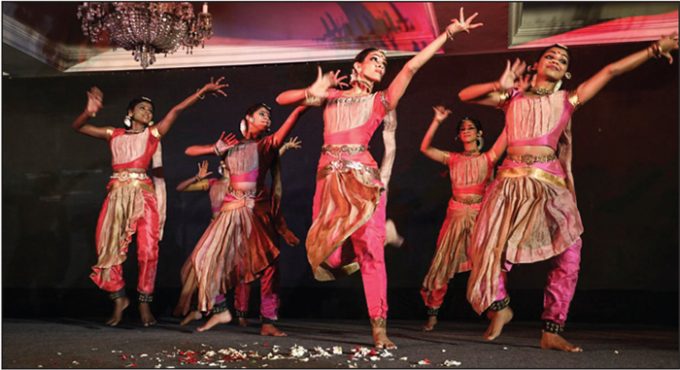

Ramdas Lamb described the courses he teaches, explaining that when introducing Indic faiths he provides context to appreciate India better. He pointed out that in the West Buddhism is taught by Buddhists, Islam by Muslims, Judaism by Jews, Christianity by Christians—yet Hinduism is rarely taught by Hindus.
In the session on tourism, Anuradha Goyal pointed out that all the themes covered in the conference essentially fell under the umbrella of tourism. She mentioned how the practice of yatra, religious pilgrimage, connects all of India, ensuring that people from one part of the country would get to visit the other parts. Manish Sinha, founder of Unhotel, India, stated that the Unhotel chain offers experiences enabling non-Indians, especially visiting students, to reimagine India absent the cliches they have learned earlier.
In the education session, Dr. David Frawley noted that the soft power of India’s spiritual traditions is generated by their experiential nature. Dena Merriam of the Global Peace Initiative of Women received applause when she affirmed that she is a Hindu and has no problem with the H word. Likewise, German-born author and resident of India Maria Wirth came across as an unapologetic Hindu who would like fellow Hindus to be unabashed in their pride for their faith, one that propagates connectedness and consciousness.
The conference concluded with a discussion on the soft power of language and literature, chaired by Makarand Paranjape of the Indian Institute of Advanced Studies in Shimla. He lamented the lack of critical editions or translations of many major Indic texts. Paul Palmarozza, Director of Sanskrit at St. James school in London, explained how their children are taught Sanskrit from an early grade. The audience was enchanted with a video snippet of his British students chanting shlokas before the Queen.
Chirapat Prapandvidya, Professor of Sanskrit Studies, Silpakorn University, Thailand, spoke about the connect between the culture of India and Thailand, primarily due to the influence of Buddhism. He surprised many by mentioning in passing that India had played a key role in Thailand being the only South Asian country not colonized in the 19th century.
US author Robert Arnett emphasized—as did Vice President Naidu—that for millennia India has been the guardian of divine truth for all of humanity. He asked Indians of the 21st century to shoulder the same responsibility and guide the spiritually bankrupt Western civilization.
Oscar Pujol, an Indologist from Spain, shared his view that hard power does not survive without soft power. He gave the collapse of Soviet Union as an example of hard power withering for lack of soft power. Hard power, he postulated, gives results in the short term, but not in the long run.
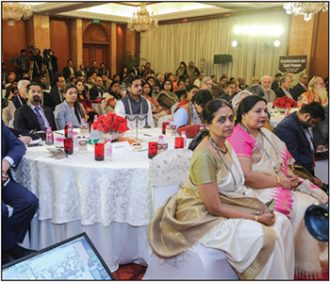
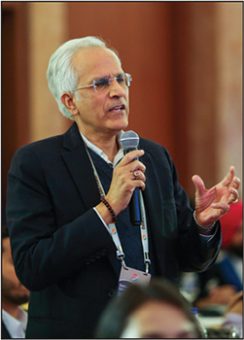

Paramacharya Sadasivanathaswami, editor of Hinduism Today, spoke about the work the magazine has been doing to raise awareness about Hindu traditions, sensibilities and culture across the globe. He emphasized the need for exploring the soft power of Hindu temples and the community and worshipfulness they nurture. These amazing expressions of Hindu belief and practice drive pilgrimage and tourism, bringing seekers from around the world.
The majestic splendor of a Hindu temple fosters a oneness with the Divine that must be experienced to be believed, and India should leverage this latent potential. The government and other organizations should showcase more than the Taj Mahal as a symbol of Incredible India.
Paramacharya said, “We have thousands of years of sacred spaces in the form of temples which can offer spiritual refuge to the world disenchanted with the faiths that brook no questioning and seeking and demand absolute adherence to a book. With more than one thousand Hindu temples in America, and hundreds in Europe, we already have vibrant regional ambassadors of Indian knowledge and goodwill across the Western world.”
The question is, are we willing to tap this hidden power? Just because we are a so-called secular country, we need not shy away from our country’s heritage, which is intrinsically Hindu. It is time that we talk earnestly about our temples and acknowledge their strategic place in the constellation of soft powers. It is time that Indians accept, embrace and revel in the soft power of having inherited the longest extant civilization in the world.
The conference concluded with those inspiring thoughts. Business cards and email addresses were exchanged and plans made for future small conferences, starting with Singapore in January, 2019, under the auspices of the India Foundation’s Center for Soft Power.
Who Owns the Narrative?
BY THE EDITORS OF HINDUISM TODAY
One speaker stood out to us from the rest: Jonathan McClory of London-based Portland Communications. The company is essentially a high-end public relations firm which, among other tasks, yearly publishes a “Soft Power 30 Report” ranking the top 30 countries of the world in soft power. Mr. McClory’s problem was quite evident, and he addressed it immediately in his speech: Why isn’t India in those top 30? According to Portland’s research, India ranked 42, while 19 European countries ranked in the top 30. These included Norway (13), Finland (15), and Ireland (19)—each with barely five million people and hardly soft power gladiators.
We can’t say he had a particularly good explanation for these implausible results. Whatever the list was measuring, it wasn’t what many attendees, after two days of speeches from experts on the topic, understood as “soft power.” What clearly was an exercise of soft power, however, was Portland’s claiming the prerogative to issue such a list, and thereby seeking to own the global narrative on soft power.
As our readers may recognize, a parallel situation emerged in the “California textbook” fracas regarding the teaching of the history of India and the Hindu religion: who has the authority to define the historical narrative to be followed? Should it be the supposedly neutral parties in academia—those who follow Marxist interpretations of history and Freudian interpretations of religion? Or might it be equally qualified scholars who reject these interpretations and wish to present the subjects in a manner recognizable to citizens of India and to Hindus?
Prof. Arvind Sharma of McGill University in Canada addressed this question in a different context at the recent World Hindu Congress in Chicago: “Who are the people who are telling us what we are or should be at the moment?” He identified three constituencies: Western Indologists and their “Indian acolytes;” liberals, by which he means Indians who believe the best way forward for India is to adopt the culture, laws and attitudes of the West (that’s the colonized mind Lord Macau lay strove so hard to foster); and Marxists, alive and strong in India and working daily to exacerbate divisions within Indian society.
Dominant in California were Western Indologists who demanded the word India be replaced with South Asia and religion of the Vedas be used instead of Hinduism. They even stated such a religion “arguably does not exist” today—this despite the term Hindubeing on the Indian census forms, and used in both law and everyday parlance with no confusion.
How does all this relate to the current discussion on India’s soft power? First, India must follow China’s example and develop its own top historians and political scientists to replace Western Indologists and academics as the recognized experts on India.
Second, until and unless India can seize control of the narrative of its history and present-day soft power, it should assure that Western institutions wanting to dictate that narrative are kept at arm’s length, as they cannot be expected to have India’s best interests at heart.
India’s new Center for Soft Power could create and promote its own, more meaningful, ranking of the world’s soft powers, based on sound scholarship and methodology. Otherwise, the narrative of India’s soft power will skew to what the West wants it to be, excluding in the process any soft powers that might hinder Western interests.
